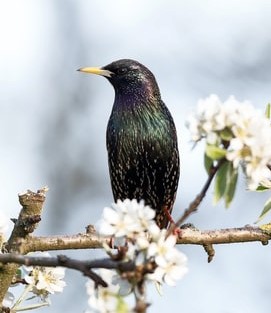May is here, Boris is back at his desk and we are closer to getting our Freedom Day than we were last week!
Due to lockdown, it has been a busy few weeks here at APC Pest HQ. People at home are now discovering ‘pests’ that normally they wouldn’t see. In Pest Watch for May, we will share with you some of the things at home you will need to watch out for.
With 2 Bank Holidays you may be clearing out the loft and doing more DIY than normal and Starlings and The Cockchafer (May Bug) are particularly busy during this time of year. Here is how to handle them properly.
Starlings Are Protected
Starlings are protected under the Wildlife & Countryside Act 1981 as they are in decline, which means they cannot be disturbed without applying for a special licence, while nesting. At home ourselves last year we found Starlings nesting in our fascia’s, so I know what it’s like first-hand to live with them, to the point where we had to move into the back bedroom to get away from the constant squawking.
In the wild, Starlings will nest in holes and cavities, especially in trees, but will often use the gaps in fascia’s and soffits of homes and this is when they become a problem, so what can be done?
Through trial and error, during my time with the Starling’s we came up with a solution that has continued to keep them out. Once the last of the fledglings had flown the nest, we installed a brush into the gutters around the house & closed any gaps around the roof verge and tiles.
The key is to close as many gaps as you can find as it is likely the adult breeding birds will return. We have also added a bird box to the garden replacing their home – all done to help them and re-home them
Interesting Facts about Starlings
Whilst they are noisy, if you take the time to really look at the Starling, they have the most amazing colours, Purple to Green iridescent with a yellow beak.
Fact File:
- Wingspan 37-42cm
- Length 21cm
- Weight 75-90g
- Lay’s 4-6 eggs in Mid-April
- UK breeding population is 1.8 Million
What is truly special about the Starling, is its ability to fly on mass, a murmuration (flock of) of starlings is an amazing sight, thousands of birds swooping, swirling and whirling in the sky above.
The Cockchafer (May Bug)
Often seen buzzing around the garden on a May evening they are known as May bugs. They are quite large and very noisy so can be a little worrying, but they are harmless to humans.
But not so harmless to plants, so the gardeners among us might what to keep an eye on their hard work. May Bugs will often find their way into our homes as the light fades through open windows as they are attracted to artificial light if possible try not to have windows fully open during the evening.
If you have any pest problems and need our help then we can help even during the lockdown as we are now officially a key service, so do get in touch
Look out for June’s edition of PestWatch with more useful guidance on what to look out for.
Stay Safe
Dan – The Pest Man












